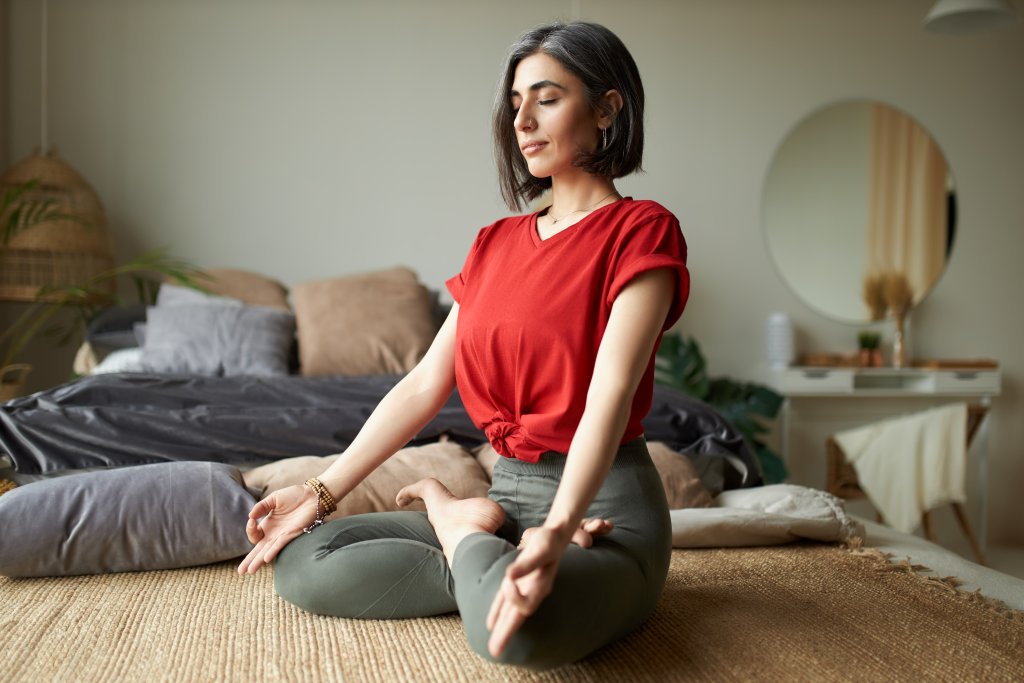Amidst the hustle and bustle of contemporary life, finding moments of peace and clarity can feel like a luxury. Yet, the ancient practice of mindfulness meditation offers a simple, accessible way to cultivate calm, reduce stress, and enhance emotional balance—all from the comfort of your own home. Whether you’re new to meditation or looking to deepen your practice, this guide will walk you through what is mindfulness meditation and how to do it at home with practical steps, benefits, and tips to create your own mindful routine.
Looking to begin meditating in the comfort of your home? These techniques will enrich your practice, making it both enjoyable and easy to practice.
- What is mindfulness meditation?
- Key benefits of practicing mindfulness at home
- How to Start Mindfulness Meditation at Home
- Sample Mindfulness Routine for Home
- Should you use guided meditation
- Mindful Meditation at home FAQs
What Is Mindfulness Meditation?

Mindfulness meditation is the art of bringing your full attention to the present moment—observing your thoughts, sensations, and surroundings without judgment. This practice encourages a gentle awareness of your breath, bodily sensations, and mental activity, helping you connect deeply with “now” rather than dwelling on past regrets or future worries.
Practicing mindfulness at home allows you to integrate this calming technique into your daily life, fostering clarity of thoughts, emotional resilience, and a peaceful mind. The beauty of mindfulness is its simplicity and adaptability—you don’t need special equipment or a spiritual background to begin.
Key Benefits of Practicing Mindfulness at Home
The benefits of a consistent mindfulness practice are well-documented and profound. Here are some of the most compelling reasons to start meditating at home:
Reduces Stress & Anxiety
Mindfulness activates the parasympathetic nervous system, which helps lower cortisol—the body’s primary stress hormone. Even a few minutes of mindful breathing daily can serve as an effective relaxation practice, reducing tension and emotional reactivity. This natural stress reduction supports overall mental and physical health.
Improves Focus & Mental Clarity
By training your brain to pay attention to the present, mindfulness meditation rewires neural pathways to reduce distractions and enhance concentration. This leads to improved productivity and sharper decision-making, making it an excellent tool for anyone seeking clarity of thoughts.
Enhances Emotional Balance
Regular mindfulness practice helps cultivate emotional awareness and regulation. It reduces impulsive reactions and promotes thoughtful responses, contributing to better emotional balance and improved interpersonal relationships. The benefits of mindfulness for emotional balance extend into all areas of life, from work to personal connections.
Promotes Better Sleep
Practicing mindfulness meditation before bedtime calms the nervous system, preparing your body and mind for restful sleep. Techniques like mindful breathing and body scans are especially effective for those struggling with insomnia or restless nights. This is why mindfulness meditation for better sleep is becoming a popular natural remedy.
How to Start Mindfulness Meditation at Home
Creating a nurturing environment and a simple routine is key to making mindfulness meditation a sustainable habit. Here’s a step-by-step guide to get you started:
Step 1: Create a Peaceful Meditation Space
Designate a quiet, uncluttered corner in your home as your meditation spot. It doesn’t need to be elaborate—just a cushion or yoga mat, soft lighting, and minimal distractions will suffice. Adding elements like incense, calming music, or plants can enhance the ambiance.
Consistency is important, so use this space regularly to build your daily meditation routine. A dedicated mindfulness meditation setup at home helps your mind associate the space with relaxation and focus.
Step 2: Choose a Comfortable Posture
Comfort is crucial. Sit cross-legged on the floor or upright in a chair with your feet flat. Keep your spine aligned to stay alert yet relaxed. If sitting is uncomfortable, lying down is an option, though it may increase the chance of falling asleep.
Rest your hands gently on your lap or knees. This posture supports a calm body and mind, which is essential for a successful relaxation practice and mindful living.
Step 3: Start With Short Sessions
If you’re a beginner, start with 5 to 10 minutes of meditation. You can use guided sessions or simply sit in silence, focusing on your breath. Gradually increase your session length to 20 or 30 minutes as your focus and comfort improve.
Using a timer or meditation app helps maintain consistency. Try to meditate at the same time daily to form a lasting habit. This approach answers the common question of how to start mindfulness meditation for beginners.
Step 4: Focus on Your Breath
Your breath is the anchor of mindfulness practice. Gently bring your attention to the natural rhythm of your inhale and exhale. When your mind wanders, acknowledge the distraction without judgment and return your focus to your breathing.
Experiment with breathing techniques like box breathing or anulom vilom pranayama to deepen relaxation and concentration. These techniques enhance your ability to maintain attention to breath and cultivate calm.
Step 5: Be Gentle With Yourself
It’s normal for your mind to wander during meditation. The practice of mindfulness is about observing these moments with kindness and patience, without self-criticism. Each time you bring your awareness back to the breath, you strengthen your mindfulness muscle.
Incorporate self-awareness and gratitude into your sessions to amplify emotional benefits. Remember, mindfulness is a journey, not a destination.
Sample Mindfulness Routine for Home
Here’s a simple daily routine to keep you centered and emotionally balanced throughout the day:
TIME
ACTIVITY
6:30 AM
5-minute breathing + 5-minute body scan |
12:30 PM
3-minute mindful pause before lunch
9:30 PM
10-minute guided meditation for sleep
This balanced schedule integrates mindfulness seamlessly into your day, supporting a mindful routine and sustained well-being.
Should You Use Guided Meditation?
Guided meditation is especially helpful for beginners. Apps like Calm, Headspace, and Insight Timer offer free and paid sessions that provide instructions and gentle encouragement. YouTube also hosts countless guided mindfulness meditation at home videos.
Using guided meditations can help maintain focus, deepen your practice, and make meditation more approachable. It’s an excellent way to build confidence and consistency in your daily meditation practice.
Guided Meditation at Home-FAQs
Q1: How long should I meditate daily at home?
Start with 5–10 minutes and gradually increase to 20–30 minutes for deeper benefits.
Q2: Can mindfulness help with anxiety?
Yes! Mindfulness has been scientifically shown to reduce anxiety and improve overall mental well-being.
Q3: Is it okay if I fall asleep during meditation?
Absolutely normal, especially when starting out. Try meditating seated and earlier in the day to stay alert.
The true power of mindfulness meditation lies in consistent mindfulness practice. Even a few minutes each day can transform your emotional health, mental clarity, and overall quality of life.
Remember, mindfulness is not about doing more but about being fully present. As you cultivate this practice at home, you’ll discover a wellspring of peace, resilience, and joy that enriches every moment.
Embark on your mindfulness journey today, and watch as your home transforms into a sanctuary of calm and clarity. Happy meditating!






